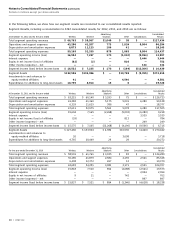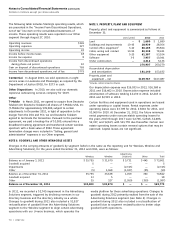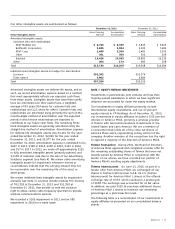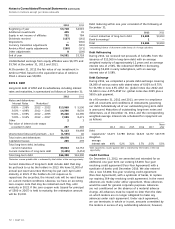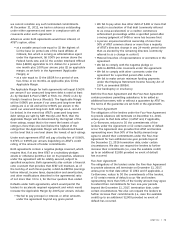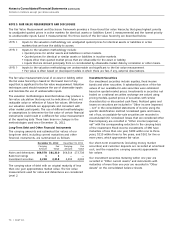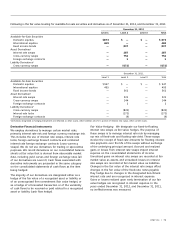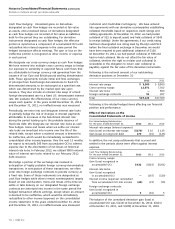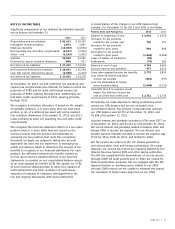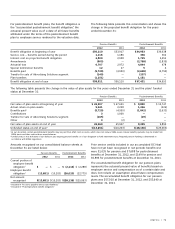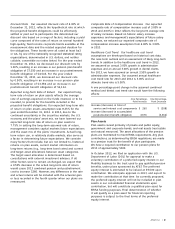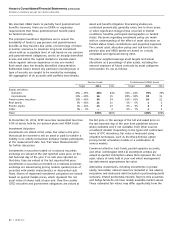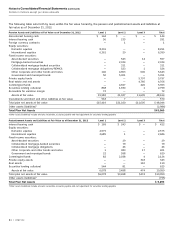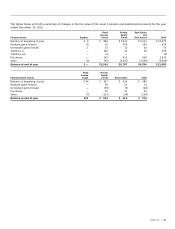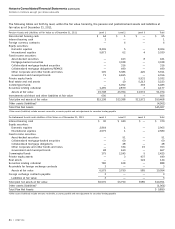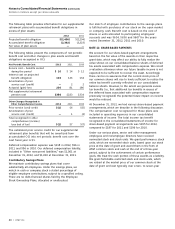AT&T Wireless 2012 Annual Report Download - page 80
Download and view the complete annual report
Please find page 80 of the 2012 AT&T Wireless annual report below. You can navigate through the pages in the report by either clicking on the pages listed below, or by using the keyword search tool below to find specific information within the annual report.
Notes to Consolidated Financial Statements (continued)
Dollars in millions except per share amounts
78 | AT&T Inc.
NOTE 11. PENSION AND POSTRETIREMENT BENEFITS
Pension Benefits and Postretirement Benefits
Substantially all of our U.S. employees are covered by one
of our noncontributory pension and death benefit plans.
Our newly hired management employees participate in a cash
balance pension program, while longer-service management
employees participate in a pension program that has a
traditional pension formula (i.e., a stated percentage of
employees’ adjusted career income) and a frozen cash
balance, or a program that has a defined lump sum formula.
Nonmanagement employees’ pension benefits are generally
calculated using one of two formulas: benefits are based on a
flat dollar amount per year according to job classification or
are calculated under a cash balance plan that is based on an
initial cash balance amount and a negotiated annual pension
band and interest credits. Most nonmanagement employees
can elect to receive their pension benefits in either a lump
sum payment or an annuity.
We also provide a variety of medical, dental and life
insurance benefits to certain retired employees under various
plans and accrue actuarially determined postretirement
benefit costs as active employees earn these benefits.
During 2012, approximately 90,000 collectively bargained
employees ratified new agreements. For the vast majority of
covered employees, the agreements provided for a pension
band increase of 1 percent for each year of the agreement.
These agreements also provide for continued health care
coverage with a modest increase to employee costs over the
agreement term. There were also modest increases to retiree
costs for continued health care coverage for retirees.
During 2012, we transferred the funding of the payment of
postretirement death benefits not already in the Voluntary
Employee Benefit Association (VEBA) trust from the pension
trust to the postretirement VEBA trust.
In 2011, we announced that beginning in 2013, as a result of
federal healthcare reform, we would begin contracting with a
Medicare Part D plan on a group basis to provide prescription
drug benefits to certain Medicare eligible retirees. This plan
change resulted in the adoption of plan amendments during
the fourth quarter of 2011, and will allow the Company to be
eligible for greater Medicare Part D plan subsidies over time.
Obligations and Funded Status
For defined benefit pension plans, the benefit obligation is
the “projected benefit obligation,” the actuarial present value,
as of our December 31 measurement date, of all benefits
attributed by the pension benefit formula to employee
service rendered to that date. The amount of benefit to be
paid depends on a number of future events incorporated into
the pension benefit formula, including estimates of the
average life of employees/survivors and average years of
service rendered. It is measured based on assumptions
concerning future interest rates and future employee
compensation levels.
The components of income tax (benefit) expense are as follows:
2012 2011 2010
Federal:
Current $ 451 $ (420) $ 307
Deferred – net 2,256 2,555 (2,105)
2,707 2,135 (1,798)
State, local and foreign:
Current 702 23 141
Deferred – net (509) 374 495
193 397 636
Total $2,900 $2,532 $(1,162)
A reconciliation of income tax expense (benefit) and the
amount computed by applying the statutory federal income
tax rate (35%) to income from continuing operations before
income taxes is as follows:
2012 2011 2010
Taxes computed at federal
statutory rate $3,654 $2,351 $ 6,383
Increases (decreases) in
income taxes resulting from:
State and local income taxes –
net of federal income
tax benefit 85 210 441
Goodwill Impairment — 961 —
Healthcare Reform Legislation — — 917
IRS Settlement – 2008
Wireless Restructuring — — (8,300)
Other – net (839) (990) (603)
Total $2,900 $2,532 $(1,162)
Effective Tax Rate 27.8% 37.7% (6.4)%
In March 2010, comprehensive healthcare reform legislation,
which included a change in the tax treatment related to
Medicare Part D subsidies, was enacted. We recorded a $995
charge to income tax expense in our consolidated statement
of income during the first quarter of 2010 and increased our
deferred income taxes liability balance to reflect the impact
of this change.
In September 2010, we reached a settlement with the IRS
on tax basis calculations related to a 2008 restructuring of
our wireless operations. The IRS settlement resolved the
uncertainty regarding the amount and timing of amortization
deductions related to certain of our wireless assets.
We recorded an $8,300 reduction to income tax expense
in our consolidated statement of income during the third
quarter of 2010 and corresponding decreases of $6,760 to
our net noncurrent deferred income tax liabilities and $1,540
to other net tax liabilities to reflect the tax benefits of the
settlement. The IRS settlement resulted in a reduction to our
UTBs for tax positions related to prior years of $1,057, which
also reduced the total amount of UTBs that, if recognized,
would impact the effective tax rate.


